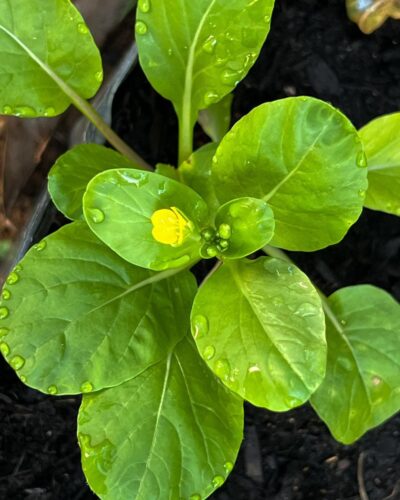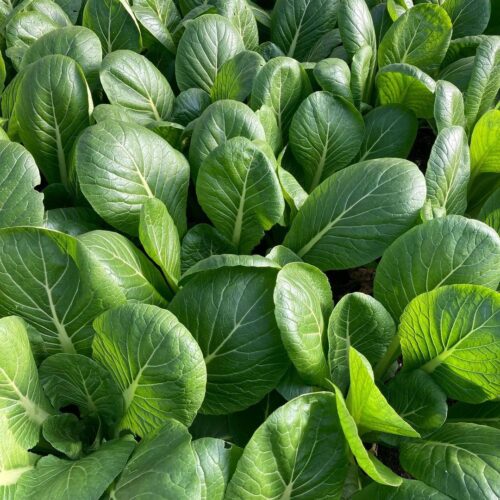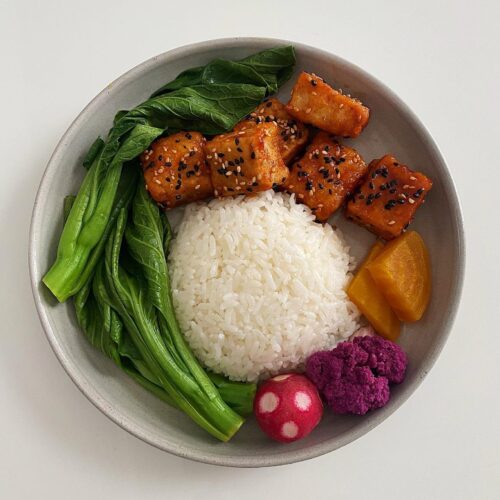Read everything about Choy Sum (YU Choy) Growing and Care Tips in this detailed guide and relish this nutritious leafy green in your cuisines.
Discover the Choy Sum (YU Choy) Growing and Care Tips in this guide; this nutritious leafy green, commonly used in Asian cuisine, can thrive in your garden with a little know-how. Find the details below.
Botanical Name: Brassica chinensis var. parachinensis
Common Names: Choi Sum, False Pak Choi, Chinese flowering cabbage oil greens, Yu Toy, Yu Choy, Yu Cai, mosk pak choy, white flowering cabbage
USDA Zones: 4-10
Check out Carolina Reaper Growing Tips
What is Choy Sum (YU Choy)?

Family: Choy Sum belongs to the Brassicaceae family, which includes various leafy vegetables like broccoli and cabbage.
Native Place: Choy Sum is native to East Asia, particularly China. It is commonly grown and consumed in many Asian countries.
Appearance: YU Choy is a leafy green vegetable with long, slender stems and dark green leaves. It has small, yellow flowers that bloom at the tip of the stems.
Growth Rate: Choy Sum is known for its fast growth. It typically reaches maturity within 30 to 40 days after sowing the seeds.
Height and Spread: YU Choy plants usually grow to a height of about 12 to 18 inches (30 to 45 centimeters) and have a spread of 6 to 8 inches (15 to 20 centimeters).
Flowers: Choy Sum produces clusters of tiny, bright yellow flowers that are edible but often left to mature into seed pods.
Foliage: The leaves of YU Choy are dark green, smooth, and glossy. They have a mild, slightly mustard-like flavor.
Additional Information: Choy Sum is a popular vegetable in Asian cuisine, often used in stir-fries, soups, and salads. It is rich in vitamins and minerals, particularly vitamins C, K, and calcium. YU Choy is easy to grow and is well-suited for home gardening. It prefers cool weather and can be grown in both spring and fall. Regular harvesting of the tender stems and leaves encourages continued growth.
DISCOVER Rare Blue Apple Varieties
How to Propagate Choy Sum

- Seed Propagation
- Cutting Propagation
Easiest Method of propagation: Seed Propagation
- Fill a seed tray or small pots with seed starting mix or a well-draining soil mix. Ensure that the soil is moist but not waterlogged.
- Sow YU Choy seeds evenly across the surface of the soil. Gently press them into the soil or cover them with a thin layer of soil, following the seed packet instructions for planting depth.
- Water the soil thoroughly but gently to avoid disturbing the seeds. You can use a watering can with a fine spray or a spray bottle.
- It requires plenty of light to germinate and grow. Place the seed tray or pots in a location with bright, indirect sunlight, or use grow lights if you’re growing them indoors.
- Cover the tray with plastic wrap or a clear plastic dome to create a mini greenhouse effect and maintain humidity.
- Keep the soil consistently moist but not soggy. Water whenever the top inch of soil feels dry.
- Once the seedlings have grown a few inches tall and have at least two true leaves, thin them out by removing the weaker seedlings, leaving only the strongest ones.
- When the Choy Sum seedlings are around 4-6 inches tall and have a good root system, transplant them into your garden or larger pots with proper spacing, typically 6-12 inches apart.
- Continue to care for your YU Choy plants by providing adequate water and nutrients as needed. Harvest the leaves and stems when they are at the desired size for consumption.
Read Tips for Growing Eggplant in Containers
Pot Size for Growing Choy Sum
For Choy Sum, start with a 6-inch diameter pot for initial potting, using a well-draining potting mix. Repot to a 10-12 inch pot when it outgrows the initial one. Ensure pots have drainage holes to prevent waterlogging.
Find Tips to Grow Purple Broccoli
Ideal Growing Conditions for Choy Sum

Location
Seedlings of Choy Sum require bright, indirect light indoors or fluorescent grow lights. Established plants thrive in full sun to partial shade, best facing south or southeast, getting at least 6 hours of sunlight daily for healthy growth and good harvests.
Soil
Choy Sum prefers well-draining, loamy soil with a pH range of 6.0 to 7.0. Amend the soil with compost or well-rotted organic matter at a ratio of 1:1 to improve fertility and moisture retention. Proper soil preparation ensures robust growth and healthy YU Choy plants.
Water
For seedlings, keep soil consistently moist, not soggy, using gentle watering methods when the top inch is dry. Established plants need deep but less frequent watering, maintaining even soil moisture by watering at the base when the top 2 inches are dry, typically 1-2 times weekly.
Temperature
Choy Sum thrives in temperatures between 50°F to 75°F (10°C to 24°C). It’s suitable for USDA Zones 4-10, making it adaptable to a wide range of climates. Planting and growing within this temperature range ensures optimal growth and productivity for YU Choy.
Read White Broccoli Information Guide
Choy Sum Care

Fertilizer
Opt for organic choices like compost, fish emulsion, worm castings, and bone meal. Apply them every 6-8 weeks, which works well. Alternatively, you can use a 10-10-10 or 14-14-14 fertilizer. Dilute it to half strength and feed for larger Choy Sum leaves every 4-6 weeks.
Pests and Diseases
Pests:
- Aphids: These tiny insects feed on plant sap, causing distorted growth and transmitting diseases. Use insecticidal soap or neem oil to control them.
- Flea Beetles: Flea beetles create small holes in leaves, affecting the plant’s health. Apply a barrier such as row covers or use insecticides if the infestation is severe.
- Cabbage Worms: These green caterpillars feed on Choy Sum leaves. Hand-pick them or use Bacillus thuringiensis (BT) to control their population.
- Slugs and Snails: These mollusks can chew on Choy Sum leaves. Remove them manually or use organic slug baits.
Diseases:
- Downy Mildew: This fungal disease causes yellowing and browning of leaves with fuzzy growth on the undersides. Improve air circulation and avoid overhead watering to prevent it.
- Powdery Mildew: A white, powdery substance on leaves is a sign of powdery mildew. Use fungicides or apply a baking soda solution (1 tablespoon per gallon of water) to treat it.
- Clubroot: Clubroot is a soil-borne disease that causes root deformities and stunted growth. Practice crop rotation and use well-draining soil to reduce its impact.
- Black Rot: Black rot affects the leaves, turning them yellow with black veins. Remove affected leaves promptly and use copper-based fungicides.
To minimize the risk of pests and diseases, practice good garden hygiene, maintain proper spacing between plants for air circulation, and avoid overwatering. Regularly inspect your Choy Sum for any signs of trouble and take prompt action to address any issues.
Learn How to Grow Watermelon from Seeds
Harvesting Choy Sum
- Timing: Choy Sum can be harvested at various stages of growth, depending on your preference. Young leaves and stems are tender and mild, while more mature plants may have slightly stronger flavors. Harvest as per your taste.
- Harvesting Young Leaves: For baby Choy Sum leaves, begin harvesting when they are about 4-6 inches tall. Use a pair of clean, sharp scissors or garden shears to snip off the top 3-4 inches of the plant. This encourages branching and continuous growth.
- Full Harvest: If you prefer a fuller harvest, you can cut the entire plant when it reaches a height of 12-18 inches. Make a clean cut at the base of the stem. Leave a few inches of the plant intact to allow for regrowth.
- Selective Harvest: Choy Sum can be harvested selectively by cutting individual leaves and stems as they reach the desired size. This allows you to extend the harvest period.
- Harvesting Flowers: If you allow YU Choy to bolt and produce flowers (which are edible and slightly spicy), harvest them when the flower buds are still tight and green.
- Harvesting Seed Pods: Choy Sum seed pods are edible and can be harvested when they are young and tender. Harvest them before they become tough and woody.
- Regular Harvesting: To encourage continuous growth and prevent the plant from becoming overly mature and tough, harvest YU Choy about once a week during the growing season.
- Handling: Handle harvested Choy Sum gently to avoid bruising or damaging the delicate leaves and stems.
- Storage: Use freshly harvested YU Choy promptly for the best flavor and nutrition. If you need to store it, place it in a plastic bag in the refrigerator’s crisper drawer. It should stay fresh for up to a week.
Learn Tips to Grow Annatto Achiote
Choy Sum Uses

Also known as Chinese flowering cabbage or yau choy, it is a versatile leafy green vegetable that can be used in a variety of dishes. Its mild, slightly bitter flavor and tender stems make it a popular ingredient in Chinese and other Asian cuisines. Here are some common uses for choy sum:
1. Stir-Fries:
Choy sum is frequently used in stir-fries. It cooks quickly and pairs well with a variety of proteins (such as chicken, beef, pork, shrimp, or tofu) and other vegetables. A simple stir-fry with garlic, soy sauce, and a touch of sesame oil is a popular preparation.
2. Steamed:
YU Choy can be steamed as a side dish or added to more elaborate steamed dishes. Serve it with a light drizzle of soy sauce or oyster sauce for extra flavor.
3. Noodle Dishes:
Add choy sum to noodle dishes like lo mein or chow mein. The vibrant green color and tender texture of the leaves and stems can enhance the visual appeal of these dishes.
4. Soup:
Choy sum can be used in soups, including clear broths and noodle soups. Add it towards the end of the cooking process to retain its crispness and color.
5. Dim Sum:
Choy sum is a common filling in Chinese dim sum dishes, such as dumplings and buns. It can be combined with other ingredients like minced meat or shrimp to create delicious fillings.
6. Salads:
Choy sum can be used in salads, either raw or blanched. It adds a unique texture and a slightly bitter flavor to salads, especially when combined with other Asian-inspired ingredients and dressings.
7. Congee:
Congee, a rice porridge, can be enriched with choy sum for added nutrition and flavor. Add it to the congee during the cooking process, allowing it to wilt and infuse its flavor into the dish.
8. Side Dish:
Serve YU Choy as a simple side dish by blanching or stir-frying it lightly and seasoning it with soy sauce, oyster sauce, or a drizzle of sesame oil.
9. Hot Pot:
Choy sum can be added to hot pot dishes, where it cooks quickly in the flavorful broth and absorbs the delicious flavors of the soup base.
10. Rice Dishes:
Incorporate choy sum into rice-based dishes like fried rice or rice casseroles. It can provide an extra layer of flavor and nutrition to these dishes.
Tip: When using YU Choy, it’s essential to rinse it thoroughly to remove any dirt or impurities and trim the tough ends of the stems before cooking. Additionally, adjust the cooking time to your preference to achieve the desired level of tenderness, as some people prefer it more crisp, while others like it slightly wilted.
FIND Best Tips to Make Pepper Plants Hotter
Choy Sum Nutrition

1. Vitamins:
- Vitamin A: YU Choy is rich in vitamin A, primarily in the form of beta-carotene. Vitamin A is essential for maintaining healthy skin, vision, and immune function.
- Vitamin C: Choy sum is an excellent source of vitamin C, an antioxidant that supports the immune system, promotes healthy skin, and aids in the absorption of iron from plant-based foods.
- Vitamin K: This vegetable is high in vitamin K, which plays a crucial role in blood clotting and bone health. It helps in maintaining strong bones and reducing the risk of osteoporosis.
2. Minerals:
- Calcium: Choy sum contains a notable amount of calcium, which is vital for bone health and plays a role in muscle function and nerve signaling.
- Potassium: This mineral is present in choy sum and is essential for maintaining proper muscle and nerve function and regulating blood pressure.
- Iron: YU Choy contains some iron, though the absorption of plant-based iron is enhanced when consumed with vitamin C-rich foods.
3. Dietary Fiber:
- Choy sum is a good source of dietary fiber, which aids in digestion, prevents constipation, and supports a healthy gut microbiome. Fiber also contributes to a feeling of fullness, which can assist in weight management.
4. Antioxidants:
- Choy sum contains various antioxidants, including carotenoids (beta-carotene) and flavonoids. These compounds help protect the body’s cells from oxidative damage caused by free radicals, potentially reducing the risk of chronic diseases such as heart disease and cancer.
5. Low in Calories and Fat:
- Choy sum is low in calories, making it a suitable choice for those looking to manage their calorie intake. It is also very low in fat, which can be beneficial for heart health.
6. Phytochemicals:
- Choy sum contains phytochemicals, such as glucosinolates, associated with potential health benefits, including antioxidant and anti-inflammatory properties. These compounds are believed to contribute to the vegetable’s slightly bitter flavor.
Check out Kajari Melon Care
Choy Sum vs. Bok Choy
Bok Choy and Choy Sum are both leafy green vegetables commonly used in Asian cuisine, but they have some distinct differences:
Choy Sum:
- Also known as Chinese flowering cabbage or yau choy.
- It has thin, tender stems with small yellow flowers.
- Leaves are tender, slightly bitter, and have a distinctive appearance.
- Often used in stir-fries, soups, and steamed dishes.
- Has a milder flavor compared to Bok Choy.
Bok Choy:
- Also known as Chinese cabbage or pak choi.
- Has thick, crisp white stems with dark green leaves.
- Leaves have a more spinach-like appearance.
- Used in various Asian and non-Asian dishes, including stir-fries, salads, and soups.
- Has a mild, slightly peppery flavor and a crunchy texture.
In summary, while both Choy Sum and Bok Choy are nutritious leafy greens used in Asian cooking, they differ in appearance, flavor, and culinary uses. Choy Sum has thinner stems and a slightly bitter taste, often used in stir-fries and steamed dishes, while Bok Choy has thicker stems, a milder flavor, and is versatile in various dish


